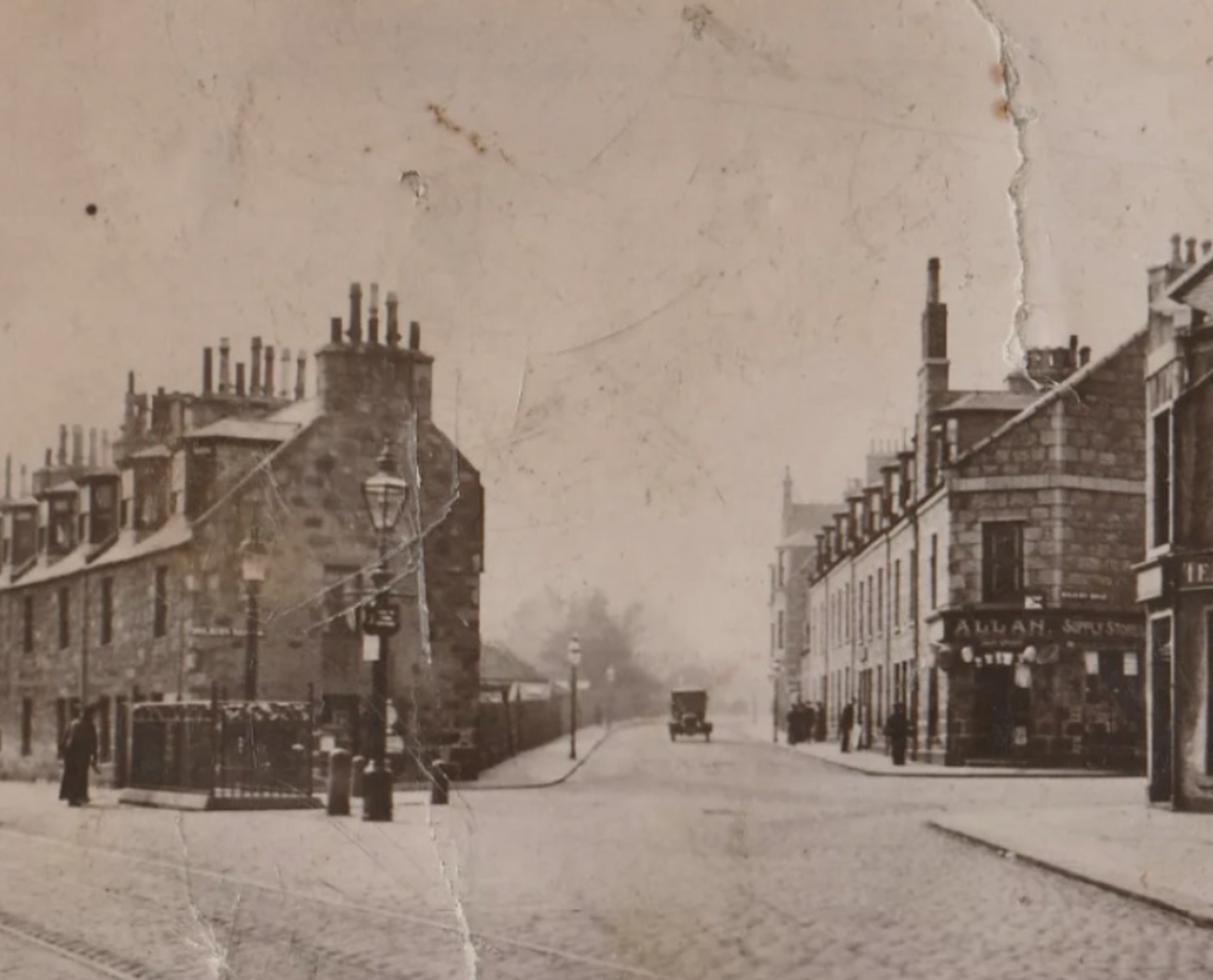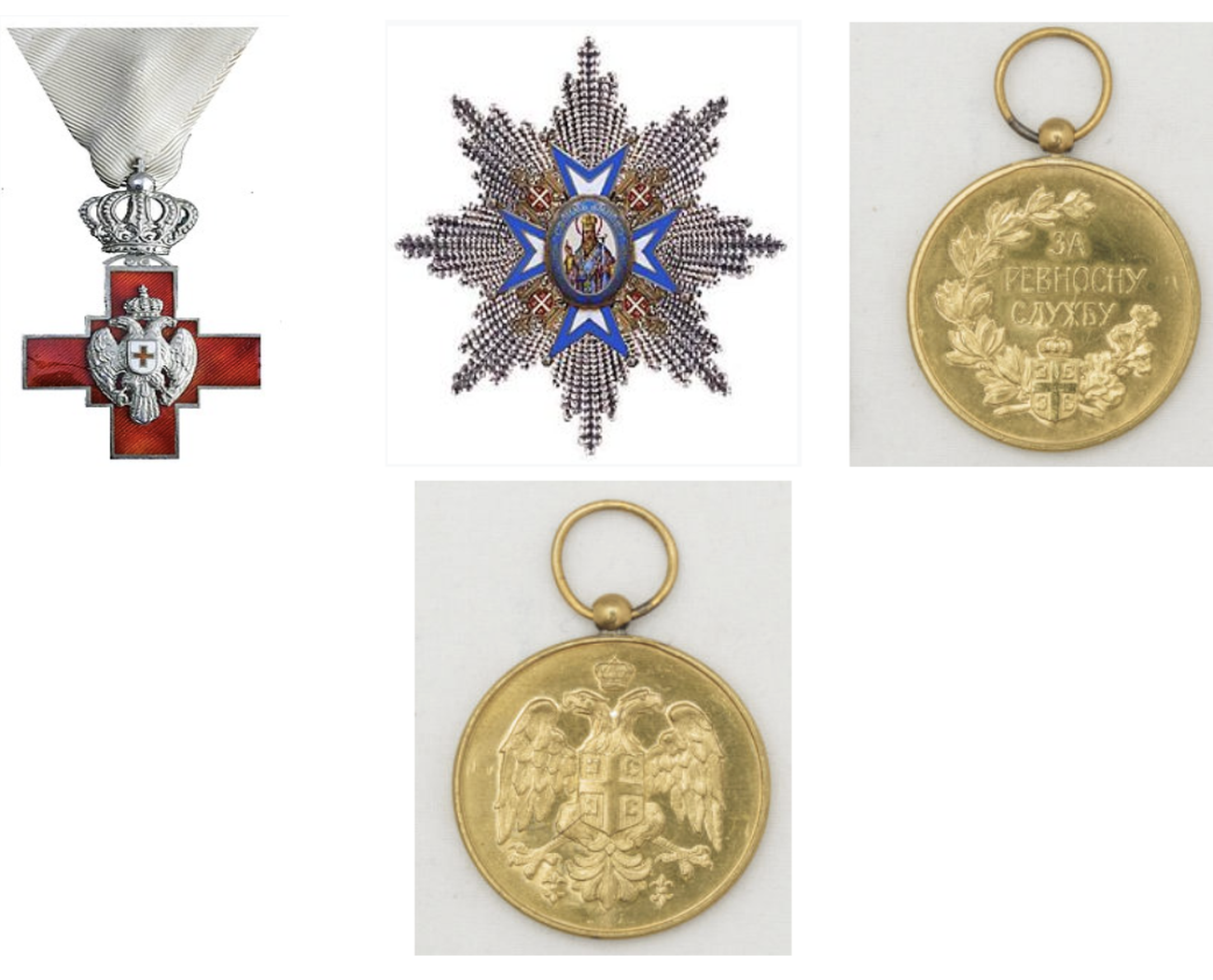Date Published: 06/01/25
Today I’m going to blog about the life of an Aberdeen city nurse...
Today I’m going to blog about the life of an Aberdeen city nurse. If some of the content seems familiar, it will be because I have already written about her on the RGU Quinepedia site a few years ago. Unfortunately, Quinepedia is no longer available and as I have found more information on Louise I think it’s worth reposting her story, so here goes…
She was born on the 6th December 1886 at Coutts Close, Holburn Street, Aberdeen, the daughter of William Sinclair and Elizabeth Jane Esson. Her parent’s marriage was not a happy one, her mother raised her, working as a tailor’s assistant. She instigated divorce and remarried John Elrick, a mechanical engineer.

Holburn St, Aberdeen. Coutts Close would have been slightly further up the road from here, heading towards Union St, just the other side of what is now the Holburn Bar.
Facebook – Aberdeen history and photos from the past (2024).
By the time Louise was 14 years old, she was working as a tailor’s machinist, living with her mother and stepfather at Spa Street, Aberdeen. The 1911 census reported that she had been promoted to a tailoress, still living with her parents at 175 Skene Street. Her maternal grandfather was a master tailor, which goes a long way to explaining her, and her mother’s, occupations.
Shortly after 1911, Louise decided to change her career, she began her nursing training at Ruchhill Hospital in Glasgow. After her training, Louise returned to Aberdeen for a short time and was employed at the Northern Nursing Home. She soon returned to Glasgow, where she worked at the East Park Home, in Maryhill, between 1915 to 1917 – this was a residential nursing home for children who had additional support needs, it still exists today. While working there she studied for a certificate in Fever Nurse Training. She would have met other nurses who were keen to play their part for King and Country, at home and abroad. By 1917, with all her experience she had a choice of who and where she chose to serve. She applied for a post with the Scottish Women’s Hospital (SWH).
You can view her VAD record here She would have used her parent’s Aberdeen address on her application – then 23 Thistle Street.On joining the SWH Louise was assigned to the Ostrovo Unit, which was based near Lake Ostrovo in Macedonia, about 90 miles west of Salonika.
If you would like some insight into the journey Louise took to join her unit, check out a fantastic blog about Margaret Box, another SWH nurse who spent time travelling and working with Louise. The link to the blog is here. Louise and Margaret shared accommodation in Rome as they travelled to join their unit. They also worked together at the 49th Stationary Hospital in Greece, while they were awaiting their orders to travel to Lake Ostrovo. They explored the countryside together on their time off and it’s here that we find out that Louise was terrified of cows. I love these wee bits of information and character you can gain from family letters!
When Louise arrived at the Ostrovo Unit, she worked in a field hospital of approximately 200 tents, the Chief Medical Officer in charge of the unit was Dr Emslie, another Scot. The Unit was often referred to as the ‘America Unit’ because most of its funding came from America. Louise served with the Unit between the Sept 1918 until August 1919. The Unit was under command of the Serbian Army.
Shortly after Louise’s arrival at Lake Ostrovo the armistice with Bulgaria was announced and the Unit had orders to move – the Unit staff were given the opportunity to go home rather than face the difficulties and challenges of the 311 kilometre journey – no one voted to go home.
The Unit’s new post was at a village called Vranje, in Northern Serbia, they were given an army barracks to use as a hospital. The work of the Unit was compounded by the fact that the barracks were in filthy conditions and the Unit were working by candle light initially. There was no time to rest. The barracks was already overflowing with 450 extremely ill patients. Most of the surgical cases were still in their original field dressings when they were injured fighting days or more ago. Many were also suffering from broncho-pneumonia and pleurisy.
Among the many tasks the Unit had was a request to accept British soldiers from the British Transport Company, as patients in the hospital. The British soldiers were working with the Serbian Army and some were suffering from the Spanish Influenza. This was one of the very few cases where the SWH looked after British soldiers. Two wards were reserved for the British Transport Unit and when the hospital was properly set up, it provided 300 beds.
The hospital was for male military patients, but the civilian population were also in dire need of help and the unit set up an outpatient department for the women and children of the village. Many of the local population were suffering from malnutrition, and wounds from bombing and exploding shells.
Margaret Box’s blog, told that Louise suffered a bad attack of malaria towards the latter part of 1918.
Louise’s early nursing career had involved working with children, in her early years. Her choice to volunteer in a field hospital, nursing men with horrific war wounds, and sometimes dangerous disease such as typhus, showed her skills, resilience, courage and bravery. Louise travelled home to Scotland in August 1919. During her time with the Unit she would have worked with fellow Scots, I have already mentioned the commanding medical officer at her time was Dr Emslie. Louise would also worked with Aberdonian Dr Myra Mackenzie. Myra was the first female graduate in medicine at Aberdeen University in 1900. Margaret Box’s letters also mentioned another Scot, Bessie Bannerman Murdoch - I’ll introduce you to Bessie’s story in a future blog.

The Unit members were awarded many decorations for their work. The Serbian Army awarded 52 member of the unit the Serbian Royal Red Cross, several members also receive the Order of Saint Sava. The whole unit were awarded with the “Gold medal for Zealous Service”.
Sor – Wikipedia and Fusilier Museum, London

In 1921 they were also awarded the Victory Medal and the British War Medal by the British Committee of the French Red Cross.
Unfortunately, details of Louise’s life after her experiences in the Balkans, are a bit sparse. The Nursing Registration Act came into law in 1919, and initially it wasn’t compulsory to register. There is no evidence of Louise registering as a nurse with either the Scottish Register or the English/Welsh equivalent. She might have seen enough nursing during her time in the SWH, or maybe now that the war had ended, nursing work was more difficult to find…
The Electoral Roll showed Louise living with her mother and stepfather in Aberdeen, in 1920, but she wasn’t with them for the 1921 census. By 1925 she was living in Motherwell, where she married Alexander Anderson, a boilermaker by trade. They were married at Dalziel Parish Church, Motherwell. Louise’s address on her marriage record was Old Mill Road, Uddington, she didn’t list an occupation though. They had a daughter, Elizabeth Isobel Anderson, born in November 1927. The family continued to live in Motherwell until Louise’s death on the 6th May 1955, aged 68 years.
If you would like to find out more about the SWH, I would recommend the following as well as the link to Margaret Box’s experience, which I posted in the article.
Fitzroy, Y & Shaw McLaren, E. Scottish nurses in the First World War: with the Scottish nurses in Roumania by Yvonne Fitzroy & A history of the Scottish Women’s Hospitals. Leonaur Publishing, 2013.
Ross, I. Little grey partridge: First World War diary of Ishobel Ross who served with the Scottish Women’s Hospitals unit in Serbia. Aberdeen: Aberdeen University Press, 1988.
The women who went to war: a great adventure – https://www.youtube.com/watch?v=rJ43IALlvI0#:~:text=This%20is%20a%20story%20of,them%20to%20this%20very%20day